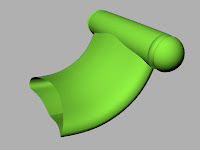Friday, 30 November 2007
03 - The Design/01
 |  |  |  |
The tureen has been designed on Rhino 3D software. The files were then exported as .stl files that could be used in Magics software for transformation into the artificial bone structure.
at
15:36
0
comments
![]()
Labels: Rhino3D software
02 - The Project
Introduction:
Technology:
The technology used in this project is beginning to shape the way that objects are designed and made.
For instance a generic hearing aid has been designed which can be customised for each individual patient and produced with no extra tooling costs. The company Freedom of Creation can design an object literally in the back of a taxi, email the design to the manufacturer nearest to the client, who then collects it. The potential to reduce the amount of international and domestic freight is one of the potential benefits of RM.
Materials:
The materials used in this project have been developed by a company in France to convert prototypes made on the Z Corp RP machine into fully functional products. They are ceramic and glass materials that require no firing, yet possess the same properties as traditional materials. They can be applied to virtually any substrate and are non-toxic, food safe, acid and alkali resistant, form a gas barrier are frost proof etc.
Icons:
To demonstrate the use of these materials I decided to take an iconic object from the first Industrial Revolution and produce it using second Industrial Revolution techniques in a way that would have been impossible 200 years ago.
I chose to design a ceramic piece based on early C18th Wedgwood, chosen because Josiah Wedgwood was at the forefront of the first Industrial Revolution, introducing division of labour, helping to develop the canal system etc. The Design:
The Design:
My starting point was the 1817 Wedgwood Creamware catalogue. I chose to base my design on the lidded tureens, combining common elements. All my design work was done using Rhino 3D software.
Imitation:
Many manufacturers including Wedgwood produced ceramics that imitated other materials. I chose to imitate a material that couldn't be produced using conventional ceramic techniques. Artificial bone was chosen for it's interesting texture and because it is produced using RP.
 |  |  |
01 - Josiah Wedgwoodn't
Josiah Wedgwoodn’t have been able to undertake this project, but as one of the fathers of the first Industrial Revolution he would certainly be at the forefront of the second Industrial Revolution if he were here today.
The Second Industrial Revolution:
Rapid manufacture [RM] and rapid prototyping [RP] are methods of 3D printing using digital data. A range of materials, from plaster, starch and plastics through to some metals can now be fabricated with increased precision and speed. As yet there are few ceramic materials for use in RM.
The technology has advanced dramatically over the past twenty years and is talked about as the Second Industrial Revolution, yet the present stage of its development is the first Industrial Revolution equivalent to the year 1800.
My entry:
My entry for the RSA Design Directions Ceramic Futures competition uses RP and highly innovative ceramic materials to reproduce an iconic ceramic object from the first Industrial Revolution in a way that was impossible in the early 1800’s.
So read on..........







